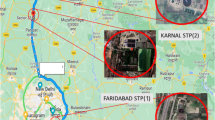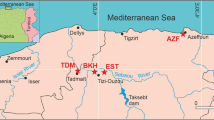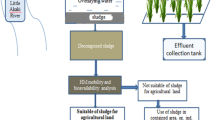Abstract
Industrial sludges from wastewater treatment plants of industrial parks and a drinking water treatment plant in northern Vietnam were investigated in this study. The total concentrations of heavy metals (As, Cd, Cu, Cr, Ni, Hg, Pb, Zn) and other elements (Mn, Pd, Sb, V) in the sludges were measured using the ICP-MS method. In addition, the surface characteristics of the samples were analyzed using SEM–EDS and FTIR techniques. According to Vietnam’s current waste management regulation, the investigated industrial sludges belonged to the hazardous waste category (with Pb concentration > 300 µg/g). In contrast, the sludge from the drinking water treatment plant had a low content of heavy metals and toxic elements. The sequential extraction method revealed that the heavy metals in the industrial sludges exhibited higher mobilization forms (exchangeable and reduceable fractions) than those in the drinking water sludges. The mobilization ability of heavy metals is probably related to the surface function groups of the sludges, which were dominated by (-COOH) and (-OH) groups. The potential ecological risk assessment calculations indicated that the industrial sludges had high potential risk (with the RI values ranging from 229.7 to 605.4), mainly due to the content of Cd in the sludge samples. Further studies about the fate and transport of Cd and other toxic metals in the sludges are highly recommended to better understand their risk to the surrounding environment, such as groundwater and agricultural soil.





Similar content being viewed by others
Data availability
The datasets used and analyzed during the current study are available from the corresponding author on reasonable request.
References
Bratina B, Šorgo A, Kramberger J, Ajdnik U, Zemljič LF, Ekart J, Šafarič R (2016) From municipal/industrial wastewater sludge and FOG to fertilizer: a proposal for economic sustainable sludge management. J Environ Manage 183:1009–1025
Cao K, Fan D, Li L, Fan B, Wang L, Zhu D, Wang Q, Tian P, Liu Z (2020) Insights into the pyridine-modified MOR zeolite catalysts for DME carbonylation. ACS Catal 10:3372–3380
Chakinala AG, Gogate PR, Burgess AE, Bremner DH (2008) Treatment of industrial wastewater effluents using hydrodynamic cavitation and the advanced Fenton process. Ultrason Sonochem 15:49–54
Chen M, Qin X, Zeng G, Li J (2016) Impacts of human activity modes and climate on heavy metal “spread” in groundwater are biased. Chemosphere 152:439–445
Dai J-y, Ling C, Zhao J-f, Na M (2006) Characteristics of sewage sludge and distribution of heavy metal in plants with amendment of sewage sludge. J Environ Sci 18:1094–1100
Fadiran AO, Tiruneh AT, Mtshali JS (2014) Assessment of mobility and bioavailability of heavy metals in sewage sludge from Swaziland through speciation analysis. American Journal of Environmental Protection 3:198–208
Fang W, Wei Y, Liu J (2016) Comparative characterization of sewage sludge compost and soil: heavy metal leaching characteristics. J Hazard Mater 310:1–10
Gomes L, Silva F, Barbosa S, Kummrow F (2012): Ecotoxicity of sludges generated by textile industries: a review. Ecotoxicology and Environmental Contamination 7
Grigatti M, Boanini E, Di Biase G, Marzadori C, Ciavatta C (2017) Effect of iron sulphate on the phosphorus speciation from agro-industrial sludge based and sewage sludge based compost. Waste Manage 69:353–359
Gunarathne V, Rajapaksha AU, Vithanage M, Adassooriya N, Cooray A, Liyanage S, Athapattu B, Rajakaruna N, Igalavithana AD, Hou D (2019): Heavy metal dissolution mechanisms from electrical industrial sludge. Science of the Total Environment 696, 133922
Hakanson L (1980) An ecological risk index for aquatic pollution control. A sedimentological approach. Water Research 14:975–1001
Hoang TH, Bang S, Kim K-W, Nguyen MH, Dang DM (2010) Arsenic in groundwater and sediment in the Mekong River delta Vietnam. Environmental Pollution 158:2648–2658
Hoppe-Jones C, Oldham G, Drewes J (2010) Attenuation of total organic carbon and unregulated trace organic chemicals in US riverbank filtration systems. Water Res 44:4643–4659
Huang L, Pu X, Pan J-F, Wang B (2013) Heavy metal pollution status in surface sediments of Swan Lake lagoon and Rongcheng Bay in the northern Yellow Sea. Chemosphere 93:1957–1964
Hung CV, Cam BD, Mai PTN, Dzung BQ (2015) Heavy metals and polycyclic aromatic hydrocarbons in municipal sewage sludge from a river in highly urbanized metropolitan area in Hanoi, Vietnam: levels, accumulation pattern and assessment of land application. Environmental Geochemistry 37:133–146
Islam MS, Ahmed MK, Raknuzzaman M, Habibullah-Al-Mamun M, Kundu GK (2017) Heavy metals in the industrial sludge and their ecological risk: a case study for a developing country. J Geochem Explor 172:41–49
Jain MS, Daga M, Kalamdhad AS (2018) Composting physics: a degradation process-determining tool for industrial sludge. Ecol Eng 116:14–20
Kartal Ş, Aydın Z, Tokalıoğlu Ş (2006) Fractionation of metals in street sediment samples by using the BCR sequential extraction procedure and multivariate statistical elucidation of the data. J Hazard Mater 132:80–89
Karvelas M, Katsoyiannis A, Samara C (2003) Occurrence and fate of heavy metals in the wastewater treatment process. Chemosphere 53:1201–1210
Landrigan PJ et al. (2018): The <em>Lancet</em> Commission on pollution and health. The Lancet 391, 462-512
Liu J-y, Sun S-y (2013) Total concentrations and different fractions of heavy metals in sewage sludge from Guangzhou, China. Transactions of Nonferrous Metals Society of China 23:2397–2407
Lo K, Chen Y (1990) Extracting heavy metals from municipal and industrial sludges. Sci Total Environ 90:99–116
Loganath R, Mazumder D (2018) Performance study on organic carbon, total nitrogen, suspended solids removal and biogas production in hybrid UASB reactor treating real slaughterhouse wastewater. J Environ Chem Eng 6:3474–3484
Men C, Liu R, Xu F, Wang Q, Guo L, Shen Z (2018) Pollution characteristics, risk assessment, and source apportionment of heavy metals in road dust in Beijing, China. Sci Total Environ 612:138–147
Meng F, Zhang H, Li Y, Zhang X, Yang F, Xiao J (2005) Cake layer morphology in microfiltration of activated sludge wastewater based on fractal analysis. Separation Purification Technology 44:250–257
MONRE (2006): Circular No. 12/2006/TT-BTNMT guiding the practical conditions and procedures for making dossiers, registration, practical licenses, hazardous waste management codes
MONRE (2013): National technical regulation on hazardous thresholds for sludges from water treatment process
MONRE (2015): Circular 36/2015/TT-BTNMT on hazardous waste management
Nguyen TC, Loganathan P, Nguyen TV, Pham TTN, Kandasamy J, Wu M, Naidu R, Vigneswaran S (2015) Trace elements in road-deposited and waterbed sediments in Kogarah Bay, Sydney: enrichment, sources and fractionation. Soil Research 53:401–411
Nowak B, Perutka L, Aschenbrenner P, Kraus P, Rechberger H, Winter F (2011) Limitations for heavy metal release during thermo-chemical treatment of sewage sludge ash. Waste Manage 31:1285–1291
Ong DC, Kan C-C, Pingul-Ong SMB, de Luna MDG (2017) Utilization of groundwater treatment plant (GWTP) sludge for nickel removal from aqueous solutions: isotherm and kinetic studies. J Environ Chem Eng 5:5746–5753
Proshad R, Islam MS, Kormoker T (2018) Assessment of heavy metals with ecological risk of soils in the industrial vicinity of Tangail district, Bangladesh. International Journal of Advanced Geosciences 6:108–116
Qiu H (2010) Studies on the potential ecological risk and homology correlation of heavy metal in the surface soil. J Agric Sci 2:194–201
Saeedi M, Li LY, Salmanzadeh M (2012) Heavy metals and polycyclic aromatic hydrocarbons: pollution and ecological risk assessment in street dust of Tehran. J Hazard Mater 227:9–17
Sekhar KC, Chary N, Kamala C, Rao JV, Balaram V, Anjaneyulu Y (2003) Risk assessment and pathway study of arsenic in industrially contaminated sites of Hyderabad: a case study. Environ Int 29:601–611
Siles-Castellano AB, López MJ, López-González JA, Suárez-Estrella F, Jurado MM, Estrella-González MJ, Moreno J (2020): Comparative analysis of phytotoxicity and compost quality in industrial composting facilities processing different organic wastes. Journal of Cleaner Production 252, 119820
Smoczyński L, Ratnaweera H, Kosobucka M, Smoczyński M (2014) Image analysis of sludge aggregates. Separation Purification Technology 122:412–420
Suresh G, Sutharsan P, Ramasamy V, Venkatachalapathy R (2012) Assessment of spatial distribution and potential ecological risk of the heavy metals in relation to granulometric contents of Veeranam lake sediments, India. Ecotoxicol Environ Saf 84:117–124
Tepanosyan G, Sahakyan L, Belyaeva O, Maghakyan N, Saghatelyan A (2017) Human health risk assessment and riskiest heavy metal origin identification in urban soils of Yerevan, Armenia. Chemosphere 184:1230–1240
Tham TT, Lap BQ, Mai NT, Trung NT, Thao PP, Huong NTL (2021) Ecological risk assessment of heavy metals in sediments of Duyen Hai Seaport area in Tra Vinh Province. Vietnam Water, Air, & Soil Pollution 232:49
Thanh-Nho N, Marchand C, Strady E, Vinh T-V, Nhu-Trang T-T (2019) Metals geochemistry and ecological risk assessment in a tropical mangrove (Can Gio, Vietnam). Chemosphere 219:365–382
Thi Trinh L, Thi Thu Trang K, Thanh Trung N, Khanh Linh N, Tham TT (2018): Heavy metal accumulation and potential ecological risk assessment of surface sediments from Day river downstream. VNU Journal of Science: Earth and Environmental Sciences 34
Thinh NV, Osanai Y, Adachi T, Vuong BTS, Kitano I, Chung NT, Thai PK (2021): Removal of lead and other toxic metals in heavily contaminated soil using biodegradable chelators: GLDA, citric acid and ascorbic acid. Chemosphere 263, 127912
Venkateswaran P, Vellaichamy S, Palanivelu K, Technology, (2007) Speciation of heavy metals in electroplating industry sludge and wastewater residue using inductively coupled plasma. Int J Environ Sci Technol 4:497–504
Viet NT, Dieu TTM, Loan NTP (2013): Current status of sludge collection, transportation and treatment in Ho Chi Minh City. Journal of Environmental Protection 2013
VSQI (2007): National Standard TCVN 5979:2007 Soil quality - determination of pH
VSQI (2011): National Standard TCVN 8941:2011 Soil quality - determination of total organic carbon - Walkley Black method
Yadav A, Garg V (2019) Biotransformation of bakery industry sludge into valuable product using vermicomposting. Biores Technol 274:512–517
Yang K, Zhu Y, Shan R, Shao Y, Tian C (2017) Heavy metals in sludge during anaerobic sanitary landfill: speciation transformation and phytotoxicity. J Environ Manage 189:58–66
Zhang H, Zhang Q, Yang B, Wang J (2014): Compacted sewage sludge as a barrier for tailings: the heavy metal speciation and total organic carbon content in the compacted sludge specimen. Plos One 9, e100932
Zhijun R, Pengfei W, Jiayu T, Zhiliu Z (2019) Effects of a low-strength magnetic field on the characteristics of activated sludge for membrane fouling mitigation. RSC Adv 9:9180–9186
Acknowledgements
We would like to thank the staff in the industrial park, industrial sludge treatment company, and the drinking water treatment plant in the North of Vietnam for facilitating us to collect samples for this study.
Funding
This research was funded by Vietnam National Foundation for Science and Technology Development (NAFOSTED) under grant number 105.08–2019.15. Nguyen Van Thinh received support from JSPS fellowship No. 20F20090 during part of this study.
Author information
Authors and Affiliations
Contributions
Phong K. Thai, Nguyen Van Thinh, Nguyen Thuy Chung, Luong Mai Ly, and Pham Minh Chinh contributed to the study’s conception and design. Material preparation, data collection, and analysis were performed by Nguyen Thuy Chung, Phan Phuong Anh, Nguyen The Huy, and Dang Thi Thuy. The data visualization and first draft of the manuscript were written by Nguyen Van Thinh and Nguyen Thuy Chung. All authors contributed to complete the final version of the manuscript.
Corresponding authors
Ethics declarations
Ethics approval and consent to participate
Not applicable.
Consent for publication
Not applicable.
Competing interests
The authors declare no competing interests.
Additional information
Responsible Editor: Severine Le Faucheur
Publisher's note
Springer Nature remains neutral with regard to jurisdictional claims in published maps and institutional affiliations.
Highlights
- The investigated sludges from industrial wastewater treatment plants were hazardous solid waste based on Vietnamese governments’ regulation.
- Cd in the sludges has the highest potential ecological risk compared to other elements.
- The industrial sludges have higher mobilization ability for heavy metals than the groundwater sludges.
- (-COOH) and (-OH) are the dominant functional groups of the sludge surfaces.
- Further studies about the fate and transport of Cd and Pb in the sludges should be conducted.
Supplementary Information
Below is the link to the electronic supplementary material.
Rights and permissions
About this article
Cite this article
Van Thinh, N., Chung, N.T., Luong, L.T.M. et al. Assessment of total concentrations of heavy metals in industrial sludges from the North of Vietnam and their potential impact on the ecosystem. Environ Sci Pollut Res 29, 42055–42066 (2022). https://doi.org/10.1007/s11356-021-17619-8
Received:
Accepted:
Published:
Issue Date:
DOI: https://doi.org/10.1007/s11356-021-17619-8




